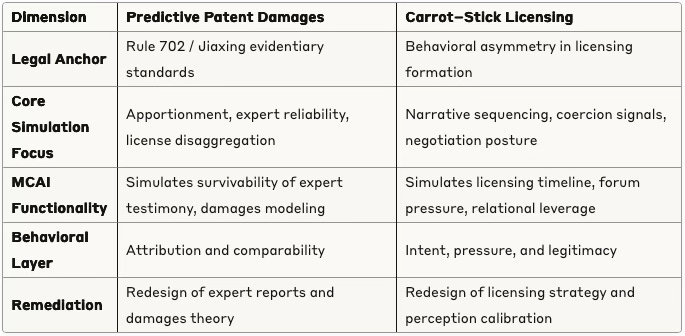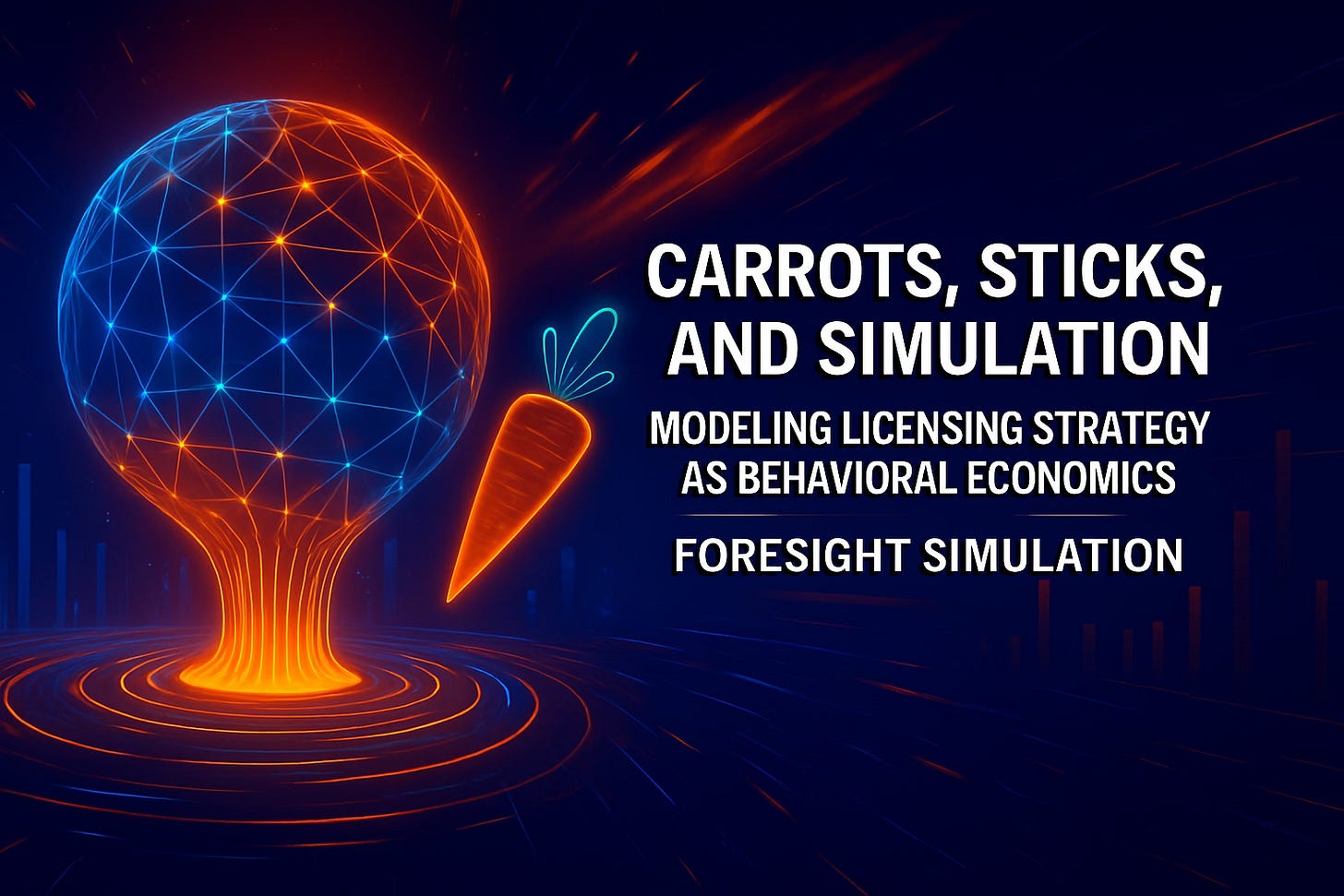MCAI Lex Vision: Carrots, Sticks, and Foresight Simulation- Modeling Patent Licensing Strategy as Behavioral Economics
From Coercive Leverage to Constructive Incentives, Rethinking Patent Licensing with Predictive Cognitive AI
This vision statement serves as a companion to our earlier framework on predictive patent damages. That prior work—Restoring Integrity in Patent Damages- Apportionment, Reliability, and the Role of Predictive Cognitive AI August 2025)—outlined how MindCast AI (MCAI) models evidentiary reliability in expert testimony, licensing apportionment, and damages theory. This follow-up extends that framework from how much was paid to why it was paid, shifting the lens from post hoc valuation to pre-signature coercion. The future of licensing lies not only in what was signed, but how and why it was structured.
I. The Licensing Spectrum: From Voluntary to Coercive
Patent licensing does not occur on a neutral playing field. Some licenses are motivated by mutual innovation and risk-sharing; others by the threat of litigation or reputational exposure. These divergent origins—often masked by identical language in agreements—create fundamentally different economic signals. Distinguishing them requires more than document review; it demands simulation of power, intent, and asymmetry.
Consider two licensing scenarios that produce identical contract language but reflect completely different realities. Carrot licensing models cooperation, goodwill, or cross-industry alignment—driven by genuine partnership and shared innovation goals. Stick licensing leverages fear, process asymmetry, or the cost of defense, motivated by litigation threats that force strategic submission rather than voluntary agreement.
Traditional legal tools rarely distinguish the two at scale, treating both scenarios as equivalent "voluntary" transactions. But MCAI changes this dynamic by analyzing how, when, and under what narrative sequence the license was pursued. The sequence matters as much as the signature.
Contact mcai@mindcast-ai.com to partner with us on foresight simulations in law and economics.
II. Why Courts Can't See Intent — But Models Can
Patent law places substantial weight on licensing agreements, yet courts are constrained by evidentiary rules that mask the power dynamics and motivations behind those agreements. Traditional valuation doctrines assume that all licensing is voluntary and symmetrical unless clear duress is proven—an unrealistic presumption in high-stakes IP disputes. Courts lack the tools to distinguish cooperation from coercion in the absence of smoking-gun evidence, leaving licensing posture legally invisible even when economically decisive.
MCAI addresses this gap by simulating the observable structure of licensing interactions rather than speculating about internal motivations. It analyzes scenario paths where licensing terms shift in response to litigation threats, forum manipulation, or economic asymmetry. For instance, if a license is signed shortly after a motion to dismiss is denied, or following the filing of a parallel ITC complaint, MCAI flags the moment as a structural inflection point. These timeline and forum-based markers are visualized in comparative licensing trajectories, offering contextual risk tiering based on historical patterns.
This simulation output isn't meant to be submitted as legal evidence but to guide practitioners, regulators, and judicial actors in identifying when licensing terms may reflect strategic submission rather than mutual value creation. MCAI's utility lies in rendering those asymmetries legible before litigation hardens them into precedent. It serves as a foresight engine—not to detect hidden intent, but to rehearse how known sequences and legal signals will be perceived under evidentiary scrutiny.
III. Valuation Divergence: When Two Licenses Aren't Alike
Courts typically evaluate license comparability based on rate, scope, and field of use—but these criteria ignore the pressure under which a license was executed. In many cases, valuation doctrine assumes voluntary participation without tools to test that assumption. This creates risk: identical-looking agreements may reflect vastly different bargaining dynamics and levels of coercion. Existing legal methods lack a standardized framework for quantifying those asymmetries.
MCAI corrects this distortion by modeling value as a function of narrative integrity. By simulating the cognitive context around each agreement, MCAI detects pricing distortions caused by fear-based leverage. It can reweight damages claims based on licensing posture, forum dynamics, and bargaining symmetry. This creates a clearer apportionment of real versus manufactured value. To avoid overloading users with new terminology, MCAI translates simulated outcomes into risk tiers, using indicators like contract sequencing anomalies and litigation adjacency flags. Rather than relying on abstract metrics, its forecasts are visualized through scenarios that contrast coercive licensing trajectories against collaborative ones drawn from a dataset of over 100 historical disputes. This allows evaluators to assess legitimacy and value based on contextually grounded signals, not new jargon.
IV. Strategic Implications for Innovators, Enforcers, and Courts
Innovators benefit from clarity: carrot-based licensing reveals shared value, while stick-based strategies may collapse under scrutiny. MCAI allows proactive companies to simulate how their licensing posture will be perceived when replayed in front of a jury, regulator, or investor. It rewards those who internalize reciprocity and penalizes those who simulate goodwill only after litigation begins.
For enforcers and courts, MCAI offers a new evidentiary lens—not to judge intent, but to model economic legitimacy. Judicial systems can use licensing posture as an interpretive layer in damages calibration. In a post-Jiaxing world, licensing motive may become a multiplier or a discount factor.
V. Conclusion: From Licensing Leverage to Legitimacy
The future of patent licensing will be shaped less by what parties claim, and more by what simulations reveal. MCAI distinguishes not only good faith from bad faith—but structure from story. Foresight modeling turns licensing strategy from a document into a behavioral signal.
As predictive systems like MCAI gain adoption, courts and counterparties will grow less tolerant of licensing fiction. The question will not be, "Did they sign?" but rather, "Under what conditions, with what leverage, and toward what intent?" Legitimacy will no longer be retroactively claimed—it will be simulated, validated, and earned.




